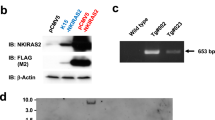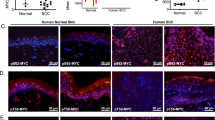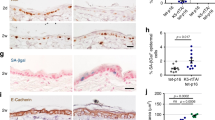Abstract
Mutations in the transforming growth factor β type II receptor (TGFβRII) have been found in various malignant tumors, suggesting that loss of TGFβ signaling plays a causal role in late-stage cancer development. To test whether loss of TGFβRII is involved in early-stage carcinogenesis, we have generated transgenic mice expressing a dominant negative TGFβRII (ΔβRII) in the epidermis. These mice exhibited an increased susceptibility to chemical carcinogenesis protocols at both early and late stages. In the current study, parameters for cell cycle progression and chromosome instability were analysed in ΔβRII tumors. ΔβRII papillomas showed an increased S phase in flow cytometry. Bromodeoxyuridine (BrdU) labeling and mitotic indices in ΔβRII papillomas also showed a threefold increase compared to papillomas developing in non-transgenic mice. When papillomas further progressed to squamous cell carcinomas (SCC), both control and ΔβRII SCC showed similar BrdU labeling indices and percentages of S phase cells. However, ΔβRII SCC cells showed a sixfold increase in the G2/M population. Mitotic indices in ΔβRII SCC also showed a threefold increase compared to non-transgenic SCC. Consistent with a perturbed cell cycle, ΔβRII papillomas and SCC showed reduced expression of the TGFβ target genes p15 (INK4b), p21 (WAF-1) and p27 (Kip1), inhibitors of cyclin-dependent kinases (cdks). However, most ΔβRII papilloma cells exhibited normal centrosome numbers, and ΔβRII SCC exhibited a similar extent of centrosome abnormalities compared to control SCC (35–40% cells). Most of ΔβRII SCC exhibited diploid chromosome profiles. These data indicate that inactivation of TGFβRII accelerates skin tumorigenesis at early stages by the acceleration of loss of cell cycle control, but not by increased chromosome instability.
This is a preview of subscription content, access via your institution
Access options
Subscribe to this journal
Receive 50 print issues and online access
$259.00 per year
only $5.18 per issue
Buy this article
- Purchase on Springer Link
- Instant access to full article PDF
Prices may be subject to local taxes which are calculated during checkout





Similar content being viewed by others
References
Aldaz CM, Conti CJ, Klein-Szanto AJ and Slaga TJ. . 1987 Proc. Natl. Sci. USA 84: 2029–2032.
Bertsch S and Marks F. . 1982 Cell Tissue Kinet. 15: 81–87.
Bottinger EP, Jakubczak JL, Roberts IS, Mumy M, Hemmati P, Bagnall K, Merlino G and Wakefield LM. . 1997 EMBO J. 16: 2621–2633.
Brinkley BR. . 1985 Ann. Rev. Cell. Biol. 1: 145–172.
Cahill DP, Lengauer C, Yu J, Riggins GJ, Willson JV, Markowitz SD, Kinzler KW and Vogelstein B. . 1998 Nature 392: 300–303.
Carcamo J, Zentella A and Massague J. . 1995 Mol. Cell. Biol. 15: 1573–1581.
Chen F and Weinberg RA. . 1995 Proc. Natl. Acad. Sci. USA 92: 1565–1569.
Chen RH, Ebner R and Derynck R. . 1993 Science 260: 1335–1338.
Conti CJ, Aldaz CM, O'Connell J, Klein-Szanto AJ and Slaga TJ. . 1986 Carcinogenesis 7: 1845–1848.
Datto MB, Li Y, Panus JF, Howe DJ, Xiong Y and Wang XF. . 1995 Proc. Natl. Acad. Sci. USA 92: 5545–5549.
Derynck R. . 1994 Trends Biochem. Sci. 19: 548–553.
Feng XH, Filvaroff EH and Derynck R. . 1995 J. Biol. Chem. 270: 24237–24245.
Filmus J and Kerbel RS. . 1993 Curr. Opin. Oncol. 5: 123–129.
Fynan TM and Reiss M. . 1993 Crit. Rev. Oncog. 4: 493–540.
Geng Y and Weinberg RA. . 1993 Proc. Natl. Acad. Sci. USA 90: 10315–10319.
Glick A, Popescu N, Alexander V, Ueno H, Bottinger E and Yuspa SH. . 1999 Proc. Natl. Acad. Sci. USA 96: 14949–14954.
Go C, Li P and Wang XJ. . 1999 Cancer Res. 59: 2861–2868.
Gorska AE, Joseph H, Derynck R, Moses HL and Serra R. . 1998 Cell Growth Differ 9: 229–238.
Greenhalgh DA, Welty DJ, Strickland JE and Yuspa SH. . 1989 Mol. Carcinog. 2: 199–207.
Hannon GJ and Beach D. . 1994 Nature 371: 257–261.
Iacopetta BJ, Welch J, Soong R, House AK, Zhou XP and Hamelin R. . 1998 J. Pathol. 184: 390–395.
Iavarone A and Massague J. . 1997 Nature 387: 417–422.
Imai Y, Tsurutani N, Oda H, Inoue T and Ishikawa T. . 1998 Int. J. Cancer 76: 407–411.
Li B, Rosen JM, McMenamin-Balano J, Muller WJ and Perkins AS. . 1997 Mol. Cell. Biol. 17: 3155–3163.
Lu SL, Akiyama Y, Nagasaki H, Saitoh K and Yuasa Y. . 1995 Biochem. Biophys. Res. Commun. 216: 452–457.
Lu SL, Kawabata M, Imamura T, Akiyama Y, Nomizu T, Miyazono K and Yuasa Y. . 1998 Nat. Genet. 19: 17–18.
Markowitz S, Wang J, Myeroff L, Parsons R, Sun L, Lutterbaugh J, Fan RS, Zborowska E, Kinzler KW and Vogelstein B. . 1995 Science 268: 1336–1338.
Murphy CS, Pietenpol JA, Munger K, Howley PM and Moses HL. . 1991 Cold Spring Harb. Symp. Quant. Biol. 56: 129–135.
Myeroff LL, Parsons R, Kim SJ, Hedrick L, Cho KR, Orth K, Mathis M, Kinzler KW, Lutterbaugh J and Park K. . 1995 Cancer Res. 55: 5545–5547.
Nagahara H, Ezhevsky SA, Vocero-Akbani AM, Kaldis P, Solomon MJ and Dowdy SF. . 1999 Proc. Natl. Acad. Sci. USA 96: 14961–14966.
Nagase H, Mao JH and Balmain A. . 1999 Proc. Natl. Acad. Sci. USA 96: 15032–15037.
Polyak K. . 1996 Biochim. Biophys. Acta. 1242: 185–199.
Polyak K, Kato JY, Solomon MJ, Sherr CJ, Massague J, Roberts JM and Koff A. . 1994 Genes Dev. 8: 9–22.
Satterwhite DJ and Moses HL. . 1994 Invasion Metastasis 14: 309–318.
Takenoshita S, Tani M, Nagashima M, Hagiwara K, Bennett WP, Yokota J and Harris CC. . 1997 Oncogene 14: 1255–1258.
van Diest PJ, Baak JP, Matze-Cok P, Wisse-Brekelmans EC, van Galen CM, Kurver PH, Bellot SM, Fijnheer J, van Gorp LH and Kwee WS. . 1992 Hum. Pathol. 23: 603–607.
Venkatasubbarao K, Ahmed MM, Swiderski C, Harp C, Lee EY, McGrath P, Mohiuddin M, Strodel W and Freeman JW. . 1998 Genes Chromosomes Cancer 22: 138–144.
Wang D, Song H, Evans JA, Lang JC, Schuller DE and Weghorst CM. . 1997a Carcinogenesis 18: 2285–2290.
Wang XJ, Greenhalgh DA, Bickenbach JR, Jiang A, Bundman DS, Krieg T, Derynck R and Roop DR. . 1997b Proc. Natl. Acad. Sci. USA 94: 2386–2391.
Wang XJ, Greenhalgh DA, Jiang AB, He D, Zhong L, Medina D, Brinkley BR and Roop DR. . 1998a Oncogene 17: 35–45.
Wang XJ, Greenhalgh DA, Jiang A, He D, Zhong L, Medina D, Brinkley BR and Roop DR. . 1998b Mol. Carcinog. 23: 185–192.
Wieser R, Attisano L, Wrana JL and Massague J. . 1993 Mol. Cell Biol. 13: 7239–7247.
Wrana JL, Attisano L, Wieser R, Ventura F and Massague J. . 1994 Nature 370: 341–347.
Acknowledgements
The authors would like to give special thanks to Dr Dennis R Roop for his critical comments on the manuscript. We would also like to thank Dr Charles J Sherr (St Jude Children Hospital, Memphis, TN, USA) for providing mouse p15 and p16 cDNA clones, and Dr Ron Balczon (University of South Alabama, Mobile, AL, USA) for providing human antiserum for PCM-1. Mrs Mattie Brooks provided excellent technical assistance. This work was supported by a Career Development Award from the Dermatology Foundation and NIH grant CA79998 to X-J Wang and NIH grant CA64255 to BR Brinkley.
Author information
Authors and Affiliations
Rights and permissions
About this article
Cite this article
Go, C., He, W., Zhong, L. et al. Aberrant cell cycle progression contributes to the early-stage accelerated carcinogenesis in transgenic epidermis expressing the dominant negative TGFβRII. Oncogene 19, 3623–3631 (2000). https://doi.org/10.1038/sj.onc.1203701
Received:
Revised:
Accepted:
Published:
Issue Date:
DOI: https://doi.org/10.1038/sj.onc.1203701
Keywords
This article is cited by
-
TGFβ: the molecular Jekyll and Hyde of cancer
Nature Reviews Cancer (2006)



